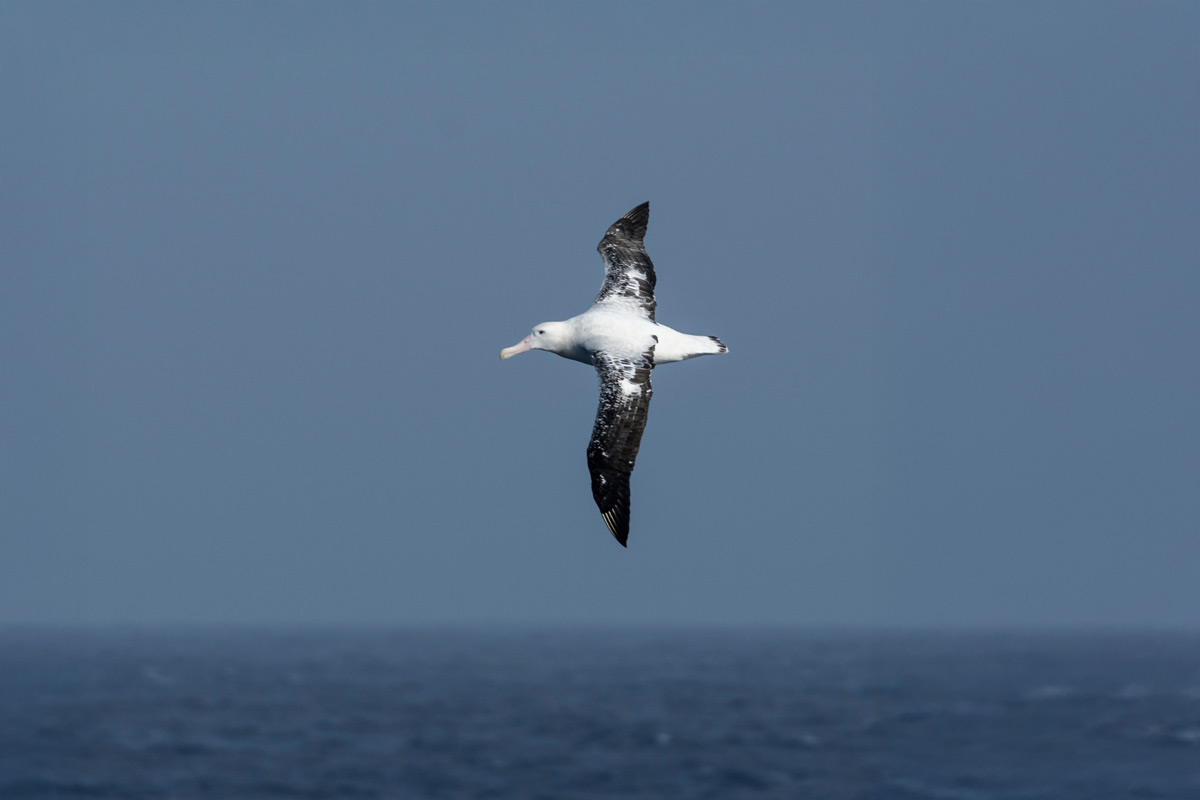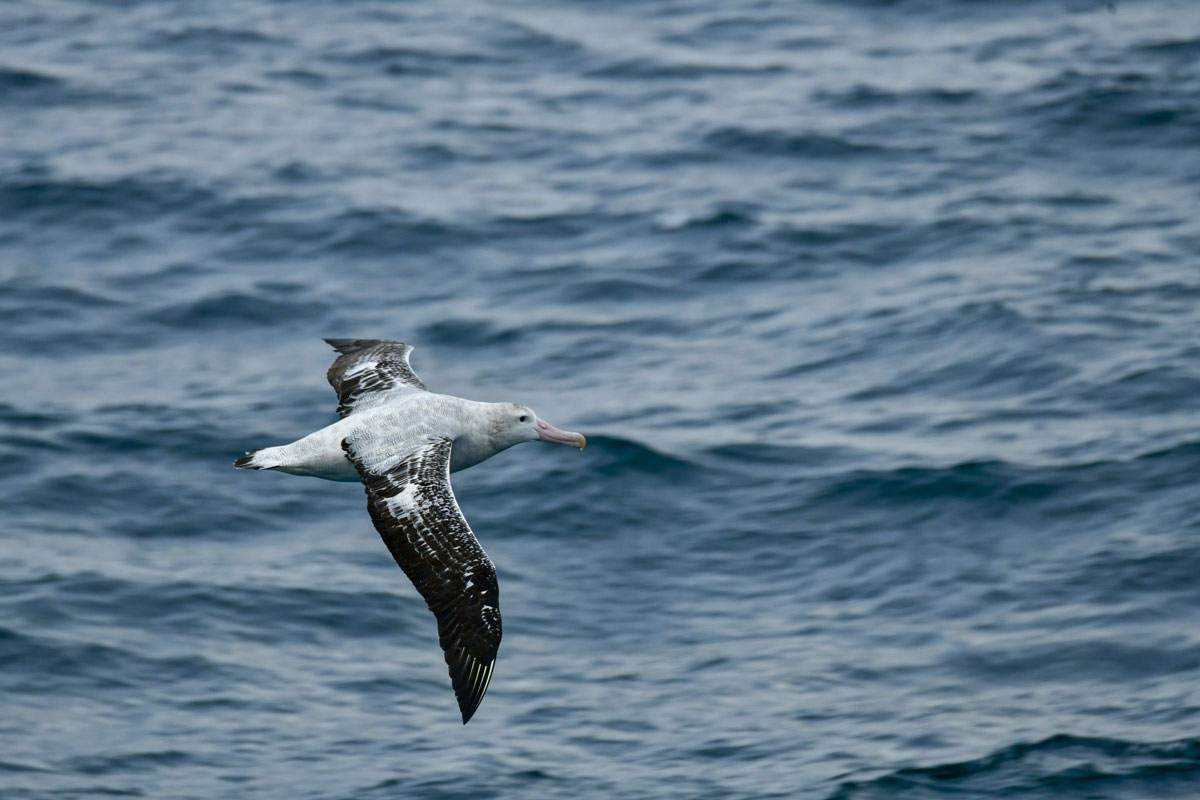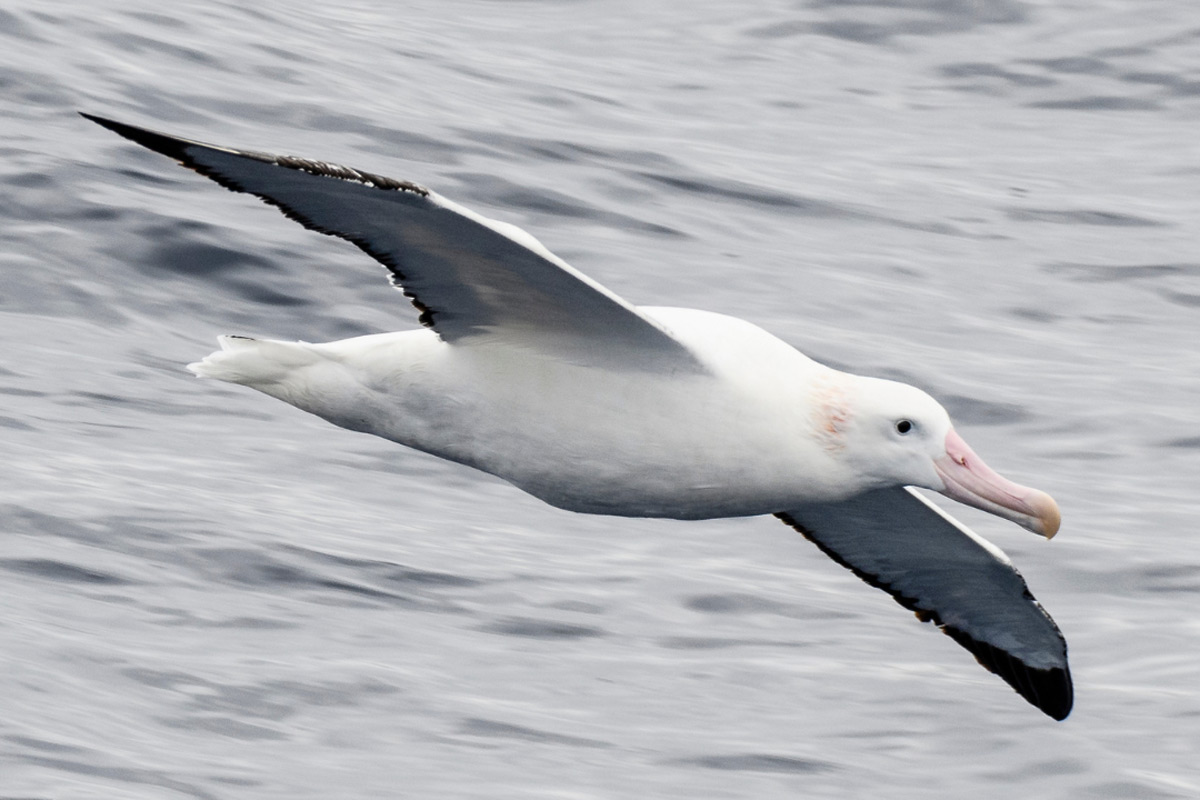Wandering Albatross
There is no mightier bird than the Wandering Albatross, a bird surrounded by lore and impressive in their size and wingspan. Also known as the snowy albatross, the white-winged albatross and simply “goonie”, these birds are one of the largest seabirds on Earth and one of the most remarkable creatures we might see on our voyages to Antarctica and the Sub-Antarctic islands.
In the past, it was believed that seeing albatrosses flying around a ship in the middle of the ocean was a sign of storms, wind, and bad weather to come. Sailors felt it was very unlucky to kill them because they believed that the spirits of deceased sailors inhabited them. From this fear came the popular phrase ‘an albatross around my neck,’ alluding to Samuel Taylor Coleridge’s poem “The Rime of the Ancient Mariner,” in which a sailor who shoots a friendly albatross is forced to wear its carcass around his neck as punishment.
Belonging to the genus Diomedea, named after Diomedes, a hero in Greek mythology, this fascinating bird from Antarctica possesses many interesting features to discover. Would you like to learn more about it?

Wandering albatross flying over the sea
Wandering Albatross Quick Overview
| Scientific Name | Diomedea exulans |
| Population | Estimated at close 20,100 globally (IUCN) |
| Regions | Sub-Antarctic islands and Southern Ocean; ranges across all oceans except the North Atlantic |
| Destinations | Falkland Islands, South Shetland Islands, Antarctic Peninsula, South Georgia, Argentina |
| Average Length | ~107-135 cm (3.5-4.4 ft) |
| Average Weight | ~5.9-12.7 kg (13-28 lbs) |
| Diet Habits | Fish, crustaceans and squid |
Questions Guests Ask About Wandering Albatross
Where Do Wandering Albatross Live?
These birds are colonial, as they typically nest together on remote oceanic islands. With a population of about 20,000 individuals and 8,000 breeding pairs, wandering albatrosses range from South Georgia Island southwards in South America to isolated islands between South Africa and Antarctica.
Is the Wandering Albatross Extinct?
The wandering albatross population trend over recent years has been decreasing, and it is classified as ‘Vulnerable’ on the IUCN Red List. Although they have no natural predators due to their large size and the fact that they spend most of their time in the air, their main threat is actually incidental mortality when they are caught on fishing hooks while attempting to steal fish or squid bait.
How Big Is a Wandering Albatross?
This huge white-backed and white-tailed albatross, with white wings bordered in black, has the largest wingspan among birds – up to 3.7 metres – measuring an average of 110-135 cm in length and weighing 6-13 kg. The huge wings mean that it’s a great glider, rarely needing wing strokes to stay in the air for days; a sight to be enjoyed from ships that it enjoys following on the ocean. On the other hand, it needs a long run-up to take flight, much like a big airplane.
How Long Can a Wandering Albatross Fly?
They are the most efficient travellers of all vertebrates on the planet. Young birds that do not breed fly about 200,000 km in a year, while breeding birds can travel over 22,000 km on a single foraging flight, and circumnavigate the globe in just 46 days – all while expending almost no energy. Albatrosses can fly almost three times as fast as the wind speed, using a ‘dynamic soaring’ technique that allows them to manoeuvre using their massive wings, which can fly up to 40 km per hour. They have a mechanism within the base of the wing to “lock” it in an extended position. This means the bird doesn’t need to strain to keep its wings out.
How Do Wandering Albatross Sleep?
Since they spend much of their life in the air, these giant birds primarily sleep while floating on the ocean’s surface. Albatross are able to soar through the sky without flapping their wings for several hours at a time, actually using up less energy in the air than they would while sitting in their nest.
How Does Their Reproduction Work?
When they reach sexual amturity, these birds lay only one large egg every two years, which parents take turns incubating for about two and a half months from November/December, and the chick needs nine months of care before it can fly on its own. It then flies away and fends for itself for years and only becomes sexually mature when it is around eight to ten years old, where it then returns to its birthplace for breeding.

Imagine photographing one of these splendid birds in flight?
How Many of These 10 Wandering Albatross Facts Did You Already Know?
- Males and females will bond with the use of ritualized dances, and their bonds last the lifetime of the pair.
- They can mate for life.
- The wandering albatross diet consists mainly of squid, octopus and fish.
- The most well-known characteristics of this bird are its enormous size, wingspan, and white plumage when it becomes an adult.
- They have a long lifespan, which can reach up to 50 years old.
- They can live up to 60 years old.
- As the birds age, the dark patches on their wings receding, making the bird looks whiter over time
- If you place a wandering albatross next to a human, you’ll notice that its wings can be larger than a person.
- Wandering albatross can reach speeds up to 127 km/hr (79 mph).
- They can weigh up to 12.7 kg (28 lbs).

Contact Us
If you are fascinated by birds then you have to come on a trip and see a Wandering Albatross for yourself! Bird lovers and even non-birders find spotting Albatross an amazing experience. Reach out to our team to learn more about our voyages any time
